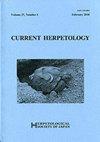物种分布模型为日本本地和外来淡水龟的不同空间分布模式提供了新的见解
IF 0.7
4区 生物学
Q4 ZOOLOGY
引用次数: 1
摘要
摘要/ Abstract摘要:日本特有淡水龟是日本山麓地区最常见的龟类,而在日本低地环境中却很少见到或稀少。相反,另一种龟,里夫斯塘龟(M. reevesii),通常生活在低地地区。对这一模式的解释仍然存在争议,因为一些研究强调,这一模式不是本土的,而是从中国大陆和朝鲜半岛引进的。新提出的假设是,M. reevesii和最近引进的红耳滑虫(Trachemys scripta elegans)将M. japonica排除在低地地区的某些适宜栖息地之外。为了验证日本稻原是否具有广泛的分布范围,覆盖了目前稻原和秀丽隐杆线虫所特有的生境,我们利用MaxEnt和ENMTools建立物种分布模型,分别估算了日本稻原、稻原和秀丽隐杆线虫的适宜生境和生态位,并对这些相似性进行了检验。模型结果表明,与外来种相比,粳稻的适宜生境范围最大,从平原到山麓;然而,几乎整个本土龟和外来龟的栖息地都是重叠的。此外,这些龟具有显著的高生态位相似性。尽管精确的生态和进化过程尚未确定,但这些结果与最近物种相互作用塑造了本土和外来海龟分布的假设是一致的。本文章由计算机程序翻译,如有差异,请以英文原文为准。
Species Distribution Modeling Provides New Insights into Different Spatial Distribution Patterns among Native and Alien Freshwater Turtles in Japan
Abstract: The endemic Japanese freshwater turtle Mauremys japonica is the most common turtle in foothill areas, whereas it is usually absent or scarce in lowland environments in Japan. In contrast, another turtle, Reeves' pond turtle (M. reevesii), usually inhabits lowland areas. Explanation of this pattern based on habitat segregation between M. japonica and M. reevesii remains controversial because several studies have emphasized that M. reevesii is not indigenous but rather introduced from mainland China and the Korean Peninsula. The newly proposed hypothesis is that M. reevesii and the recently introduced red-eared slider (Trachemys scripta elegans) have excluded M. japonica from certain suitable habitats in lowland areas. In this study, to test whether M. japonica originally had a broad distribution range covering the habitats currently occupied exclusively by M. reevesii and T. s. elegans, we applied species distribution modeling using MaxEnt and ENMTools to estimate the suitable habitats and ecological niches of M. japonica, M. reevesii, and T. s. elegans, respectively, and examined these similarities. The models showed that M. japonica had the largest suitable habitat range, from flatlands to foothill areas, compared to that of alien species; however, almost the entire habitat area of the native turtle and that of the aliens overlapped. Moreover, these turtles possessed significantly high niche similarity. These results are consistent with the hypothesis that recent species interactions have shaped the distribution of indigenous and alien turtles, although the precise ecological and evolutionary processes have not yet been determined.
求助全文
通过发布文献求助,成功后即可免费获取论文全文。
去求助
来源期刊

Current Herpetology
Agricultural and Biological Sciences-Animal Science and Zoology
CiteScore
1.20
自引率
14.30%
发文量
20
期刊介绍:
Current Herpetology publishes original research articles on amphibians and reptiles. It is the official journal of the Herpetological Society of Japan and is a continuation of Acta Herpetologica Japonica (1964–1971) and Japanese Journal of Herpetology (1972-1999).
 求助内容:
求助内容: 应助结果提醒方式:
应助结果提醒方式:


